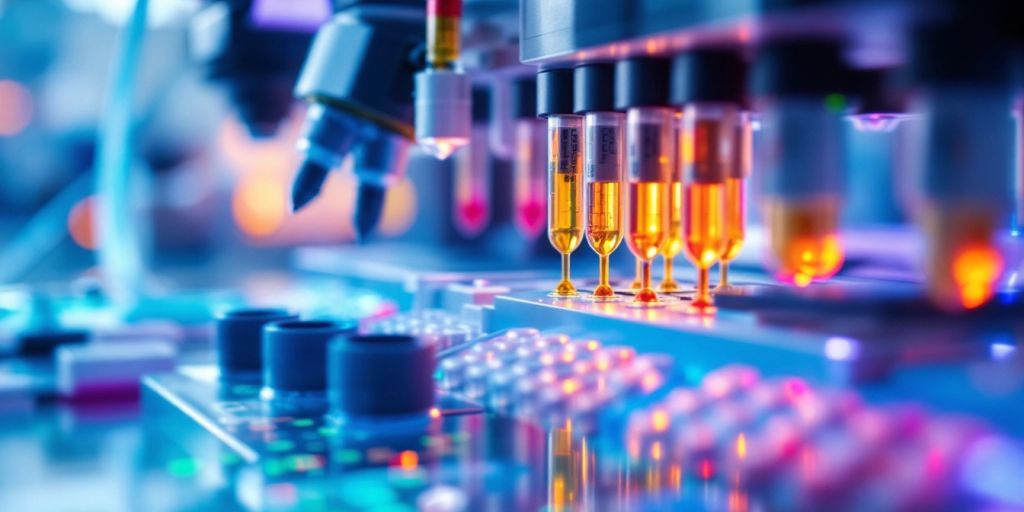
Cell sequencing is changing the way we understand genes and health. New technologies are helping scientists look at individual cells, which can tell us a lot about diseases and how our bodies work. This article will explore the latest advancements in cell sequencing, its uses in medical research, the challenges we face, and what the future might hold. It will also touch on how cell sequencing can help us learn about evolution and the importance of making these technologies available to everyone.
Key Takeaways
- Single-cell sequencing helps scientists study one cell at a time, revealing important details about health and diseases.
- New techniques in cell sequencing are making it easier and faster to analyze DNA and RNA from individual cells.
- Cell sequencing is being used in medicine to create personalized treatments for cancer and other illnesses.
- Despite its benefits, cell sequencing faces challenges like high costs and the need for better data analysis tools.
- Making cell sequencing affordable and accessible is key to helping researchers and doctors around the world.
Advancements in Single-Cell Sequencing Technologies
Emerging Techniques in Single-Cell RNA Sequencing
Single-cell RNA sequencing (scRNA-seq) has made huge strides in recent years. This technology allows scientists to look at the gene activity of individual cells. Some of the new methods include:
- Drop-seq: A technique that uses tiny droplets to capture single cells.
- 10x Genomics: A platform that enables high-throughput analysis of thousands of cells at once.
- Seq-Well: A low-cost method that simplifies the process of capturing single cells.
High-Throughput Single-Cell DNA Sequencing
High-throughput single-cell DNA sequencing is changing how we study genetics. This method helps researchers analyze the DNA of many cells quickly. Key advancements include:
- Microfluidics: This technology allows for the manipulation of tiny amounts of fluids, making it easier to work with single cells.
- Whole Genome Amplification: A process that makes copies of DNA from a single cell, allowing for detailed analysis.
- Next-Generation Sequencing (NGS): This method can read millions of DNA sequences at once, speeding up research.
Integration of Multi-Omics in Single-Cell Analysis
Combining different types of data from single cells is called multi-omics. This approach gives a fuller picture of cell behavior. Some important aspects are:
- Genomics: Studying the DNA of cells.
- Transcriptomics: Looking at RNA to understand gene expression.
- Proteomics: Analyzing proteins to see how they function in cells.
The future of single-cell sequencing holds great promise, as it continues to evolve and provide deeper insights into biology.
Applications of Cell Sequencing in Medical Research

Cancer Genomics and Personalized Medicine
Cell sequencing is changing how we understand cancer. By analyzing the genetic makeup of tumors, researchers can tailor treatments to individual patients. This means that therapies can be more effective and have fewer side effects. Here are some key points:
- Identifying specific mutations in cancer cells.
- Developing targeted therapies based on genetic information.
- Monitoring treatment response through follow-up sequencing.
Cell Sequencing in Neurological Disorders
In the field of brain research, cell sequencing helps scientists learn about diseases like Alzheimer’s and Parkinson’s. It allows for:
- Understanding how different brain cells are affected by these diseases.
- Discovering new biomarkers for early diagnosis.
- Exploring potential treatments by studying cell behavior.
Immunogenomics and Vaccine Development
Cell sequencing plays a crucial role in understanding the immune system. This is important for:
- Developing vaccines that are more effective against diseases.
- Studying how the body responds to infections.
- Creating personalized vaccines based on individual immune profiles.
Cell sequencing is not just a tool; it’s a gateway to new medical breakthroughs that can save lives.
Challenges and Solutions in Cell Sequencing
Technical Limitations and Innovations
Cell sequencing has made great strides, but it still faces some challenges. One major issue is the accuracy of the data. New technologies are being developed to improve this, such as:
- Better sample preparation methods
- Advanced imaging techniques
- More sensitive detection systems
These innovations aim to enhance the reliability of results.
Data Analysis and Interpretation
Analyzing the data from cell sequencing can be tricky. The amount of information generated is huge, making it hard to understand. Here are some ways to tackle this:
- Use of artificial intelligence to help process data.
- Development of user-friendly software tools.
- Training researchers in data analysis skills.
These steps can help make sense of complex data.
Ethical Considerations in Genomic Research
As cell sequencing grows, so do the ethical questions. Important points to consider include:
- Privacy of genetic information
- Consent from individuals for their data to be used
- Potential misuse of genetic data
Addressing these concerns is crucial for responsible research.
The future of cell sequencing holds great promise, but it is essential to navigate these challenges carefully to ensure ethical and effective use.
Future Prospects of Cell Sequencing
Next-Generation Sequencing Technologies
The future of cell sequencing is bright, especially with next-generation sequencing (NGS) technologies. These advancements promise to make sequencing faster and cheaper, allowing researchers to analyze more cells than ever before. Some key features include:
- Higher throughput: More samples can be processed simultaneously.
- Improved accuracy: Reducing errors in sequencing results.
- Longer reads: Capturing more information from each DNA fragment.
Potential for Early Disease Detection
Cell sequencing can play a crucial role in spotting diseases early. By examining individual cells, scientists can identify changes that signal the start of a disease. This could lead to:
- Earlier diagnosis of conditions like cancer.
- Better monitoring of disease progression.
- Tailored treatments based on individual cell profiles.
Impact on Drug Development and Therapeutics
The innovations in cell sequencing are set to change how drugs are developed. With detailed insights from cell data, researchers can:
- Identify new drug targets more effectively.
- Test drug responses on specific cell types.
- Personalize therapies to match individual patient needs.
The advancements in cell sequencing are not just about technology; they are about transforming healthcare and improving lives.
In summary, the future of cell sequencing holds great promise, with advancements in technology paving the way for better disease detection and treatment options. Single-cell RNA sequencing offers opportunities to explore the complexities of the genome, gene expression, and other omics disciplines.
Cell Sequencing in Evolutionary Biology

Tracing Evolutionary Lineages
Cell sequencing helps scientists understand how different species are related. By looking at the genetic information from various organisms, researchers can trace back their evolutionary paths. This can show how species have changed over time and how they adapt to their environments.
Comparative Genomics Across Species
Comparative genomics involves comparing the DNA of different species. This can reveal important similarities and differences. Here are some key points:
- Identifying common genes that are crucial for survival.
- Understanding how certain traits evolved in different environments.
- Discovering genetic markers that indicate evolutionary changes.
Insights into Human Evolution
Cell sequencing provides valuable insights into human evolution. By studying ancient DNA, scientists can learn about our ancestors and how we evolved. Single-cell RNA sequencing is revolutionizing biology by providing detailed information on the RNA transcripts of individual cells. This helps in understanding how our genes have changed over time and what makes us unique as a species.
Understanding our evolutionary history is essential for grasping how we fit into the tree of life. It helps us appreciate the diversity of life on Earth and our place within it.
Commercialization and Accessibility of Cell Sequencing
Reducing Costs and Increasing Efficiency
The cost of cell sequencing has dropped significantly in recent years. This reduction is crucial for making these technologies available to more researchers and institutions. Some key factors contributing to this trend include:
- Advancements in technology that streamline processes.
- Increased competition among sequencing companies.
- Development of more efficient protocols.
Expanding Access to Developing Regions
To ensure that cell sequencing benefits everyone, it is essential to expand access in developing areas. This can be achieved through:
- Partnerships with local institutions to provide training.
- Establishing mobile sequencing units.
- Offering affordable sequencing services.
Industry Partnerships and Collaborations
Collaboration between academic institutions and industry is vital for the growth of cell sequencing. These partnerships can lead to:
- Shared resources and knowledge.
- Development of new technologies.
- Increased funding for research projects.
The future of cell sequencing relies on making it accessible to all, ensuring that breakthroughs in genomics can benefit everyone, not just a select few.
Educational and Training Programs in Genomics
Developing Curriculum for Genomics Education
Creating effective genomics education programs is essential for preparing students. Schools and universities are focusing on:
- Integrating hands-on lab experiences.
- Offering online courses for flexibility.
- Collaborating with industry experts to keep content relevant.
Training the Next Generation of Genomic Scientists
To ensure the future of genomics, training programs must:
- Provide mentorship opportunities.
- Encourage participation in research projects.
- Foster teamwork and communication skills.
Online Resources and Certification Programs
With the rise of online learning, many resources are available:
- Free webinars and workshops.
- Certification programs from recognized institutions.
- Interactive platforms for practical learning.
Investing in genomics education today will shape the scientists of tomorrow.
The University of Washington School of Medicine offers a two-year laboratory genetics and genomics fellowship, which is a great opportunity for those looking to specialize in this field. This program is designed to equip students with the necessary skills and knowledge to excel in genomics research and applications.
Conclusion
In summary, the future of cell sequencing is bright and full of exciting possibilities. As technology continues to advance, we can expect faster and more accurate ways to study our genes. This will not only help scientists understand diseases better but also lead to new treatments that can improve our health. With these innovations, we are moving closer to a world where personalized medicine is a reality, allowing doctors to tailor treatments specifically for each individual. Overall, the journey of exploring cell sequencing is just beginning, and its impact on genomics will be significant for years to come.
Frequently Asked Questions
What is single-cell sequencing?
Single-cell sequencing is a method that looks at the genetic material of individual cells. This helps scientists understand how different cells work and how they are different from each other.
How is cell sequencing used in medicine?
Cell sequencing helps doctors find out what makes diseases like cancer unique in each patient. This way, they can create treatments that are just right for each person.
What are some challenges of cell sequencing?
Some challenges include the technology not being perfect yet, the need for special skills to analyze the data, and concerns about privacy and ethics in research.
What does the future hold for cell sequencing?
In the future, cell sequencing could help catch diseases early, improve drug development, and lead to more personalized medicine.
How does cell sequencing help in understanding evolution?
By studying the genes of different species, scientists can trace how they evolved over time and learn more about human evolution.
What efforts are being made to make cell sequencing more accessible?
There are ongoing efforts to lower the costs of cell sequencing and make it available in more places, especially in developing countries.


